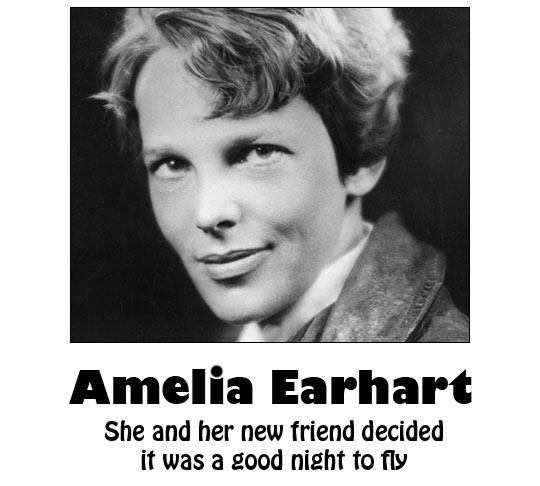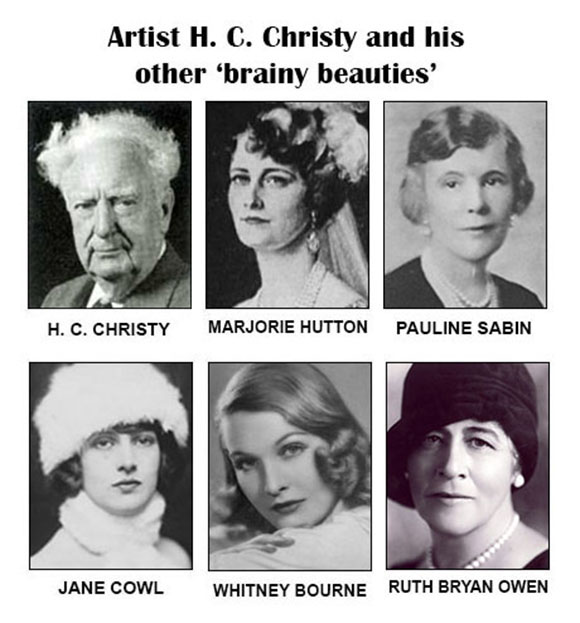
|
Amelia Earhart, who, in 1932, became the first woman to fly solo across the Atlantic Ocean, was the country's most famous female flyer (or aviatrix, as newspapers frequently labeled her).
There were many other women who were licensed pilots, several considered better flyers than Earhart, though not as enterprising, especially at generating press coverage.
Earhart made a few headlines for her flying in 1933, though the biggest stories involved the Italian fleet led by Italo Balbo, the long air journey taken by Charles Lindbergh with his wife, Anne, and attempts to circumvent the globe by pilots Jimmy Mattern and Wiley Post. There were many other fascinating, often tragic stories as well.
However, in April, Earhart and another famous woman attracted attention for one of the year's most unusual airplane adventures. It was a short, impromptu flight, and added further proof that the United States' new First Lady was going to make things interesting in Washington.
|
| |
Syracuse Journal, April 21
WASHINGTON (INS) — Delicate white gloves, brocade and slim-heeled slippers have to take life as they find it with Mrs. Franklin Roosevelt and her friend, Amelia Earhart Putnam, trans-Atlantic flier.
Tomboy-like, the pair toppled off last evening for a joy ride under misty night skies in a giant transport plane. Mrs. Putnam didn’t even remove her gloves to fly the big ship from the capital to Baltimore, and Mrs. Roosevelt spent part of the time in the pilot’s cockpit.
Both thoroughly enjoyed the trip. Mrs. Roosevelt, accustomed to night flying as is the aviatrix, caught a glimpse of the necklace of lights that seem to encircle Washington when seen from the air, and called it “Fairyland.”
The two, tall and willowy in the sleek silks of evening, seemed a strange, silent contrast amid the blackness and roaring motors of the tri-motored plane as Mrs Putnam controlled its movements with a slender, white-gloved hand. High-heeled, silken slippers applied the rudder pressure that swerved more than 10 tons of steel and fabric to the right and left. |
|
 |
Amelia Earhart and Eleanor Roosevelt
at a White House dinner before they
skipped out to go flying. |
| |
Howard Chandler Christy was an artist who made women his favorite subjects, so much so that for awhile his "Christy Girls" were nearly as well known as the "Gibson Girls" of artist Charles Dana Gibson.
Christy maintained that truly beautiful women are intelligent, and in 1933 he was asked to list some examples.
|
| |
Syracuse Journal, June 22
NEW YORK (INS) — Howard Chandler Christy, who was glorifying the American girl with drawing pencil and paint brush long before Ziegfeld produced his first revue — and who is at it still — took time off in his studio yesterday to nominate six women who illustrate his contention that beauty generally is accompanied by a high order of intelligence.
The six:
Mrs. Edward H. Hutton*, New York society woman and philanthropist.
Mrs. Charles H. Sabin, chairman of the Women's Organization for Prohibition Reform.
Miss Jane Cowl, actress.
Miss Whitney Bourne, a recent New York débutante.
Mrs. Ruth Bryan Owen, minister to Denmark.
Miss Amelia Earhart, aviatrix.
The last nomination, Mr. Christy volunteered, was sure to be a surprise. He had painted Miss Earhart's portrait recently and had been amazed at her beauty.
"Newspaper pictures never do her justice," he said.
Christy, who at present is relating his memoirs in Cosmopolitan Magazine, had no trouble recalling the old days when "The Old Sweetheart of Mine," by James Whitcomb Reilly, and illustrated by Howard Chandler Christy, was on every library table.
Poets were well paid in those days, he revealed. The young artist, who had been paid a lump sum for his pictures, asked how much Reilly was making from the widespread sale of the book. He was told:
"We have stopped figuring how much Reilly is getting a word for that poem. Our last computation showed that his royalties were $39 a letter." |
|
* This likely was an error. The middle initial probably should have been F., for Edward F. Hutton, financier and co-founder of E. F. Hutton & Co. His wife in 1933 was Marjorie Merriweather Post, socialite and founder of General Foods, Inc. She was the daughter of C. W. Post and Ella Letitia Merriweather. At 27, when her father died, she became the owner of the Postum Cereal Company, and one of the wealthiest woman in the United States.
|
 |
| |
In July, Earhart got down to the business of maintaining her reputation as a flier, and broke one of her own speed records — by almost two hours.
|
| |
Syracuse American, July 9
NEWARK, New Jersey (INS) — Amelia Earhart, noted trans-Atlantic aviatrix, last night established a new transcontinental speed for women.
She arrived at 7:19 p.m., exactly 17 hours, 7 minutes and 30 seconds after she left Los Angeles. This erased the former west-to-east record for women, also held by Miss Earhart, by almost two hours — one hour, 56 minutes and 30 seconds, to be exact.
George Palmer Putnam, publisher and husband of the aviatrix, waited all afternoon for her arrival. He reached up to the cockpit and handed her a container of water. She gulped it and then thanked him.
She said she encountered trouble only in the stretch between Albuquerque and Amarillo when, while traveling about 180 miles per hour, the hatch cover over her head became loose and for 75 miles or so she was forced to hold it down with one hand while guiding the plane with the other.
To make up lost time after leaving Amarillo, she said, “I struck up into the altitudes, flying between 6,000 and 8,000 feet in an attempt to find a favoring tail wind. I didn’t have much luck in getting help from the wind, however. I don’t think midsummer is the ideal season for establishing new high speed marks in flying. It is difficult at this time of year to find strongly favorable winds.”
Miss Earhart said she suffered from gasoline fumes throughout the entire flight, although her 700-horsepower motor worked perfectly. |
|
| |
That last paragraph mentions one of the drawbacks of being a pilot on the early days on aviation. Miss Earhart would chalk up more accomplishments in the air until 1937 when she took off on a fatal flight that resulted in an enduring mystery.
|
| |
| HOME • CONTACT |
| |
|



